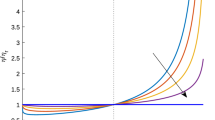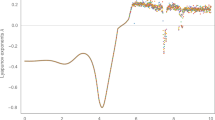Abstract
The present work extends and generalizes the notion of frequency-distributed (FD) representation to a broad class of linear, stationary, continuous-time systems. On one hand, the proposed FD representation can be seen as a generalization of the diffusive representation, which is primarily utilized in the context of fractional order systems. Alternatively, it can also be seen as an extension to the Jordan canonical form, which is used as one of the main theoretical tools when analyzing finite-dimensional systems. Sufficient conditions under which FD representation can be achieved are derived. The proposed approach ensures real-valued state functions and output weights even when applied to oscillatory systems, and in a wast majority of cases manages to avoid utilization of generalized functions. Potential applications include simulation, representation theory and stability analysis, control synthesis, etc. All considerations have been illustrated by numerical examples.
Similar content being viewed by others
References
P.J. Antsaklis, A.N. Michel, A Linear Systems Primer. Birkhäuser (2007).
T.M. Atanacković, M. Budinčević, S. Pilipović, On a fractional distributed-order oscillator. Journal of Physics A 38, No. 30 (2005), 6703–6713; DOI: 10.1088/0305-4470/38/30/006.
T.M. Atanacković, S. Konjik, S. Pilipović, D. Zorica, Complex order fractional derivatives in viscoelasticity. Mechanics of Time-Dependent Materials 20, No. 2 (2016), 175–195; DOI: 10.1007/s11043-016-9290-3.
T.M. Atanacković, S. Pilipović, D. Zorica, Diffusion wave equation with two fractional derivatives of different order. J. Phys. A Math. Theor. 40 (2007), 5319–5333; DOI: 10.1088/1751-8113/40/20/006.
R. Capponeto, S. Graziani, V. Tomasello, A. Pisano, Identification and fractional super-twisting robust control of IPMC actuators. Fract. Calc. Appl. Anal. 18, No. 6 (2015), 1358–1397; DOI: 10.1515/fca-2015-0079https://www.degruyter.com/view/j/fca.
R. Curtain, K. Morris, Transfer functions of distributed parameter systems: a tutorial. Automatica 45, No. 5 (2009), 1101–1116; DOI: 10.1016/j.automatica.2009.01.008.
R.Z. Curtain, H. Zwart, An Introduction to Infinite-Dimensional Linear Systems Theory Springer-Verlag, New York, Inc. (1995).
S. Cvetićanin, D. Zorica, M.R. Rapaić, Generalized time-fractional telegrapher’s equation in transmission line modeling. Nonlinear Dynamics 88, No. 2 (2017), 1453–1472; DOI: 10.1007/s11071-016-3322-z.
D. Valerio, J.S. da Costa, An Introduction to Fractional Control. IET, London, UK (2013).
G. Dauphin, D. Heleschewitz, D. Matignon, Extended diffusive representations and application to non-standard oscillators. Proc. of Mathematical Theory on Network Systems (MTNS). University of Perpignan, Perpignan, France (2000).
R.C. Dorf, R.H. Bishop, Modern Control Systems. Pearson Prentice Hall (2011).
R. Gorenflo, Y. Luchko, M. Stojanović, Fundamental solution of a distributed order time-fractional diffusion-wave equation as probability density. Fract. Calc. Appl. Anal. 16, No. 2 (2013), 297–316; DOI: 10.2478/s13540-013-0019-6https://www.degruyter.com/view/j/fca.
J.F. Hauer, C.J. Demeure, L.L. Scharf, Initial results in Prony analysis of power system response signals. IEEE Trans. on Power Systems 5, No. 1 (1990), 80–89; DOI: 10.1109/59.49090.
Z. Jiao, Y.Q. Chen, I. Podlubny, Distributed-Order Dynamic Systems: Stability, Simulation, Applications and Perspectives. Springer (2012).
T. Kailath, Linear Systems. Prentice-Hall (1980).
G. Korenev, Bessel Functions and Their Applications. CRC Press (2002).
P. Lanusse, J. Sabatier, PLC implementation of a CRONE controller. Fract. Calc. Appl. Anal. 14, No. 4 (2011), 505–522; DOI: 10.2478/s13540-011-0031-7https://www.degruyter.com/view/j/fca.
R.L. Magin, Fractional Calculus in Bioengineering. Begell House Publishers (2006).
F. Mainardi, Y. Luchko, G. Pagnini, The fundamental solution of the space–time fractional diffusion equation. Fract. Calc. Appl. Anal. 4, No. 2 (2001), 153–192.
D. Matignon, Generalized fractional differential and difference equations: Stability properties and modeling issues. In: Proc.of Mathematical Theory of Networks and Systems, Padova, Italy, Il Poligrafo (1998), 503–506.
D. Matignon, Stability properties for generalized fractional differential systems. In: Proc. of ESAIM Fractional Differential Systems: Models, Methods and Applications, EDP Sciences (1998), Vol. 5, 145–158.
D. Matignon, Can positive pseudo-differential operators of diffusive type help stabilize unstable systems? In: Proc. of 15th International Symposium on Mathematical Theory of Networks and Systems, University of Notre Dame, USA, https://www3.nd.edu/~mtns/cdrom.pdf (2002).
D. Matignon, Diffusive representations for fractional Laplacian: Systems theory framework and numerical issues. Physica Scripta T136 (2009), 014009; DOI: 10.1088/0031-8949/2009/T136/014009.
D. Matignon, Optimal control of fractional systems: a diffusive formulation. In: Proc. of 19th International Symposium on Mathematical Theory of Networks and Systems, Budapest, Hungary (2010).
G. Montseny, Diffusive representation of pseudodifferential time operators. In: Proc.of ESAIM Fractional Differential Systems: Models, Methods and Applications, EDP Sciences (1998), Vol. 5, 159–175.
G. Montseny, J. Audounet, B. Mbodje, Optimal models of fractional integrators and applications to systems with fading memory. In: Int. Conf. IEEE Systems, Man and Cybernetics, Le Touquet, France, IEEE (1993).
I. Petráš, Tuning and implementation methods for fractional order controllers. Fract. Calc. Appl. Anal. 15, No. 2 (2012), 282–303; DOI: 10.2478/s13540-012-0021-4https://www.degruyter.com/view/j/fca.
S. Pilipović, D. Seleši, Mera i integral–Fundamenti teorije verovatnoće. Zavod za udžbenike (2012).
A. Pisano, M.R. Rapaić, Z.D. Jeličić, E. Usai, Sliding mode control approaches to the robust regulation of linear multivariable fractional-order systems. International J. of Robust and Nonlinear Control 20, No. 18 (2010), 2045–2056; DOI: 10.1002/rnc.1565.
I. Podlubny, Fractional Differential Equations: An Introduction to Fractional Derivatives, Fractional Differential Equations, to Methods of Their Solution and Some of Their Applications San Diego-Boston-etc., Academic Press (1998).
M.R. Rapaić, Z.D. Jeličić, Optimal control of a class of fractional heat diffusion systems. Nonlinear Dynamics 62, No. 1–2 (2010), 39–51; DOI: 10.1007/s11071-010-9697-3.
A.I. Saichev, W.A. Woyczyński, Distributions in the Physical and Engineering Sciences, Volume I. Distributional and Fractal Calculus, Integral Transforms and Wavelets Birkhäuser, Boston (1997).
J.L. Schiff, The Laplace Transform–Theory and Applications. Springer (1999).
M.S. Tavezoei, Time-response analysis of fractional-order control systems: A survey on recent results. Fract. Calc. Appl. Anal. 17, No. 2 (2014), 440–461; DOI: 10.2478/s13540-014-0179-zhttps://www.degruyter.com/view/j/fca.
J.C. Trigeassou, N. Maamri, Initial conditions and initialization of linear fractional differential equations. Signal Processing 91, No. 3 (2011), 427–436; DOI: 10.1016/j.sigpro.2010.03.010.
J.C. Trigeassou, N. Maamri, A. Oustaloup, The infinite state approach: Origin and necessity. Computers and Mathematics with Applications 66, No. 5 (2013), 892–907; DOI: 10.1016/j.camwa.2012.11.020.
J.C. Trigeassou, N. Maamri, J. Sabatier, A. Oustaloup, A Lyapunov approach to stability of fractional differential equations. Signal Processing 91, No. 3 (2011), 437–445; DOI: 10.1016/j.sigpro.2010.04.024.
J.C. Trigeassou, N. Maamri, J. Sabatier, A. Oustaloup, State variables and transients of fractional order differential systems. Computers and Mathematics with Applications 64, No. 10 (2012), 3117–3140; DOI: 10.1016/j.camwa.2012.03.099.
B.J. West, M. Bologna, P. Grigolini, Physics of Fractal Operators. Springer (2003).
Author information
Authors and Affiliations
About this article
Cite this article
Rapaić, M.R., Šekara, T.B. & Bošković, M.Č. Frequency-Distributed Representation of Irrational Linear Systems. FCAA 21, 1396–1419 (2018). https://doi.org/10.1515/fca-2018-0073
Received:
Published:
Issue Date:
DOI: https://doi.org/10.1515/fca-2018-0073




